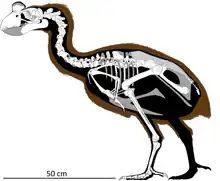Sylviornithidae
Sylviornithidae is an extinct family of flightless birds, known from subfossil bones found in Holocene aged deposits on the Melanesian islands of New Caledonia and Fiji. Traditionally assumed to be within Galliformes, recent phylogenetic studies showcase that they rest outside of the galliform crown-group, making them the most recently lived non-galliform Pangalliformes.[1] For many years it was considered a monotypic family consisting of Sylviornis alone, but recent studies show that Megavitiornis was part of this clade as well.[1]
| Sylviornithidae Temporal range: Holocene | |
|---|---|
 | |
| Skeletal reconstruction of Sylviornis | |
| Scientific classification | |
| Domain: | Eukaryota |
| Kingdom: | Animalia |
| Phylum: | Chordata |
| Clade: | Dinosauria |
| Class: | Aves |
| Clade: | Pangalliformes |
| Family: | †Sylviornithidae Mourer-Chauviré & Balouet, 2005 |
| Genera | |
References
- Worthy, T., Mitri, M., Handley, W., Lee, M., Anderson, A., Sand, C. 2016. Osteology supports a steam-galliform affinity for the giant extinct flightless birds Sylviornis neocaledoniae (Sylviornithidae, Galloanseres). PLOS ONE. doi: 10.1371/journal.pone.0150871
This article is issued from Wikipedia. The text is licensed under Creative Commons - Attribution - Sharealike. Additional terms may apply for the media files.